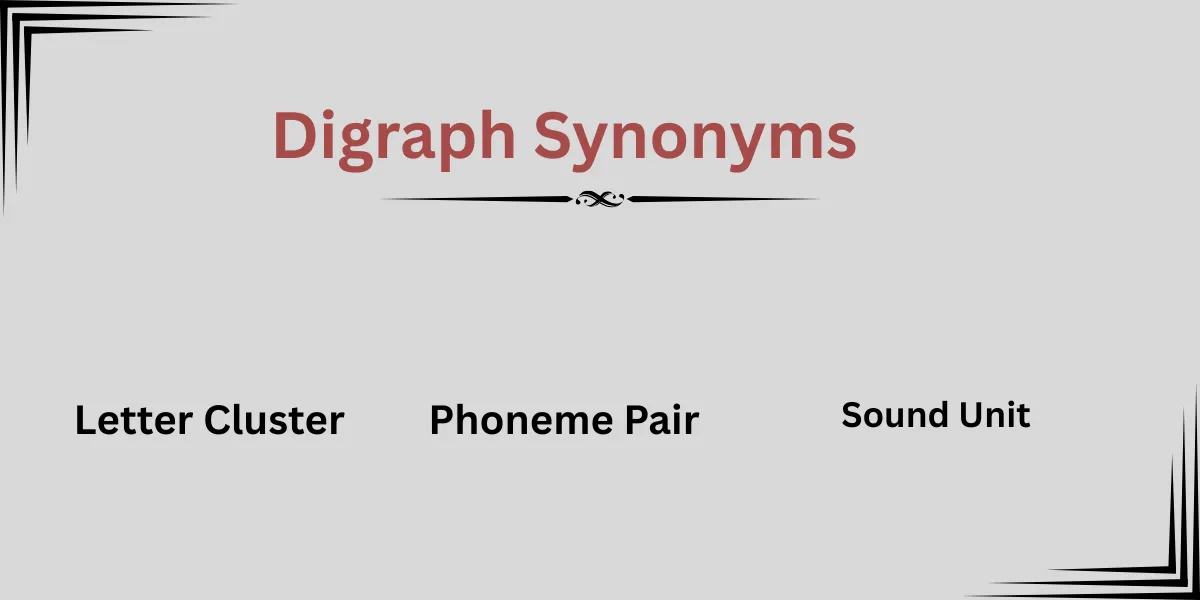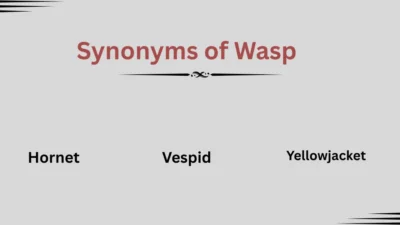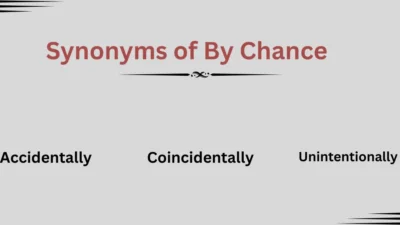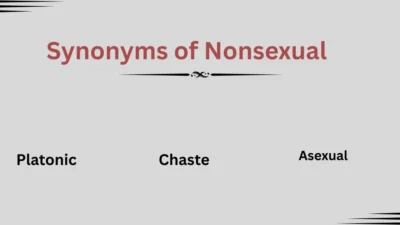Synonyms of digraph, such as letter pair, two-letter combination, and graph pair, describe two letters that come together to make a single sound in a word. For example, the th in “think” or the sh in “ship” are digraphs. These terms help you explain how letters work together in reading, spelling, and writing.
If you’re writing about language, phonics, or literacy, choosing the right synonym for digraph makes your explanation clear and easy to understand.
In this guide, you’ll learn the meaning and example sentences for each synonym of digraph, so you can discuss letter combinations with confidence and accuracy.
What Does Digraph Mean?
A digraph is a pair of letters that work together to make one sound in a word. Unlike regular letters that each make their own sound, digraphs combine to create a single pronunciation.
Depending on how it’s used, a digraph can refer to:
- Consonant digraphs — like ch in “chip” or th in “think”
- Vowel digraphs — like ea in “team” or oa in “boat”
- Phonics instruction — teaching reading and spelling
- Spelling rules — showing how letters form sounds in words
At its core, a digraph is about teamwork between letters. It helps readers and writers understand how sounds combine in language, making words easier to read and pronounce correctly.
30 Synonyms and Related Terms for “Digraph”
Each of the following terms relates to “digraph” in meaning or function. Some are technical, while others are contextual or descriptive.
1. Letter Pair
Meaning: Two letters used together in a word.
Example: “The letter pair ‘ph’ makes an /f/ sound in English.”
When to use: In teaching or informal discussions rather than linguistic research.
2. Phoneme Pair
Meaning: Two letters or symbols representing a single sound.
Example: “A phoneme pair like ‘sh’ is taught early in reading programs.”
When to use: In phonics or speech education contexts.
3. Double Letter Combination
Meaning: Two identical or different letters functioning as one sound.
Example: “The double letter combination ‘th’ is tricky for learners.”
When to use: To simplify explanation for children or language learners.
4. Sound Unit
Meaning: A basic spoken element represented by letters.
Example: “Each sound unit connects written letters to spoken words.”
When to use: In phonological studies or pronunciation teaching.
5. Letter Cluster
Meaning: A group of letters pronounced closely together.
Example: “In ‘black’, the ‘bl’ forms a letter cluster.”
When to use: When referring to letters that retain separate sounds.
6. Phonogram
Meaning: A written symbol or letter group representing a sound.
Example: “The phonogram ‘oo’ has multiple pronunciations.”
When to use: In reading instruction or linguistic research.
7. Grapheme
Meaning: The smallest unit of a writing system corresponding to a sound.
Example: “‘Ch’ is a grapheme that represents a single sound.”
When to use: In academic or linguistic discussions.
8. Letter Combination
Meaning: Any pair or group of letters that work together in a word.
Example: “‘ea’ in ‘bread’ is a letter combination.”
When to use: In neutral or general language learning contexts.
9. Orthographic Unit
Meaning: A structural unit in written language.
Example: “A digraph like ‘th’ is an orthographic unit.”
When to use: In formal or technical writing about spelling systems.
10. Consonant Blend
Meaning: Two or more consonants appearing together but keeping their sounds.
Example: “‘Br’ in ‘brown’ is a consonant blend.”
When to use: In phonics lessons where both letters are pronounced.
11. Phonetic Pair
Meaning: Two letters representing a single phonetic sound.
Example: “‘Sh’ is a common phonetic pair in English.”
When to use: When focusing on pronunciation patterns.
12. Sound Symbol Pair
Meaning: Two written characters symbolizing a single sound.
Example: “The sound symbol pair ‘ch’ can represent different sounds.”
When to use: In theoretical linguistics or semiotics.
13. Alphabet Pair
Meaning: Two letters that together form a unique sound.
Example: “The alphabet pair ‘ph’ is Greek in origin.”
When to use: In historical linguistics or etymology discussions.
14. Character Pair
Meaning: Two written symbols forming one sound or function.
Example: “‘ng’ in ‘sing’ is a character pair.”
When to use: In digital typography or language encoding contexts.
15. Double Grapheme
Meaning: Two letters functioning as a single graphemic unit.
Example: “‘wh’ is a double grapheme.”
When to use: In advanced linguistic analysis or written structure study.
16. Letter Duo
Meaning: A simple, informal way to describe two letters working together.
Example: “The letter duo ‘sh’ gives one sound.”
When to use: In casual explanations or early education.
17. Digram
Meaning: Another term for digraph; used interchangeably.
Example: “‘Ph’ in ‘phone’ is a digraph.”
When to use: Occasionally in linguistic texts or variant spelling systems.
18. Double Character
Meaning: Two written characters acting as one sound or idea.
Example: “In some writing systems, a double character replaces a single one.”
When to use: In cross-linguistic studies or code systems.
19. Bigraph
Meaning: Equivalent to digraph, especially in older or regional usage.
Example: “‘Th’ is a bigraph representing a single sound.”
When to use: In historical linguistics or philological writing.
20. Compound Letter
Meaning: Two letters combined to represent one sound.
Example: “‘Sh’ acts as a compound letter.”
When to use: In educational or descriptive language.
21. Twin Letters
Meaning: Two letters appearing side-by-side, often functioning together.
Example: “The twin letters ‘ee’ make a long vowel sound.”
When to use: In children’s literacy programs.
22. Double Symbol
Meaning: Two written marks conveying one phonetic meaning.
Example: “‘Ch’ in ‘church’ is a double symbol.”
When to use: When emphasizing symbolic representation rather than sound.
23. Merged Phoneme
Meaning: A sound created by blending two letters’ phonetic effects.
Example: “The merged phoneme ‘sh’ combines two letters.”
When to use: In speech pathology or phonetic analysis.
24. Linked Grapheme
Meaning: A connected pair of letters acting as one unit.
Example: “In cursive, the linked grapheme ‘th’ flows together.”
When to use: In handwriting studies or typography.
25. Phonetic Unit
Meaning: Any written or spoken element representing one sound.
Example: “The phonetic unit ‘ng’ occurs in many languages.”
When to use: Broadly in phonetic and phonological contexts.
26. Double Vowel
Meaning: Two vowels making a single sound (like “ea” in bread).
Example: “Children learn the double vowel rule early on.”
When to use: In vowel digraph discussions specifically.
27. Vowel Team
Meaning: Two vowels that together make one sound.
Example: “‘Ai’ in ‘rain’ is a vowel team.”
When to use: In early reading education or phonics programs.
28. Sound Cluster
Meaning: A sequence of sounds or letters grouped together.
Example: “The sound cluster ‘ch’ occurs often in English.”
When to use: When describing sound groupings broadly.
29. Phonetic Combination
Meaning: Two or more letters combining to form one pronunciation.
Example: “The phonetic combination ‘wh’ differs by dialect.”
When to use: When focusing on pronunciation differences.
30. Letter Sound Pair
Meaning: Two letters that together correspond to one sound.
Example: “‘Th’ in ‘thank’ is a letter sound pair.”
When to use: In simple, accessible explanations for beginners.
How to Choose the Right Synonym
Choosing the right alternative depends on context and audience:
- For education: Use vowel team, letter pair, double vowel, or letter sound pair for clarity.
- For linguistics: Prefer grapheme, phonogram, orthographic unit, or bigraph.
- For informal writing: A Letter duo or sound unit keeps the tone approachable.
- For phonics and teaching: Consonant blend, vowel team, and phonetic combination fit best.
- For historical or academic use: Digram and bigraph carry a scholarly tone.
Cultural context can also matter. For instance, vowel team and blend are mostly used in American English classrooms, while digraph and bigraph are preferred in British linguistics discussions.
Conclusion: Mastering the Use of Digraph Synonyms
Understanding digraph synonyms isn’t just about vocabulary—it’s about knowing how language functions at its smallest levels. Whether you’re teaching reading, studying phonetics, or analyzing orthography, each synonym adds nuance to your explanation.
By choosing the right term for your audience and purpose, you enhance clarity and precision. Remember: “sh” and “th” may seem simple, but they represent the deep, beautiful complexity of how sound meets writing.



